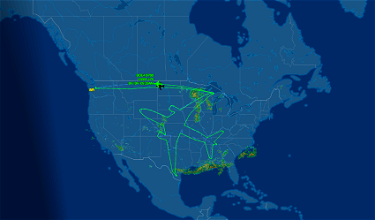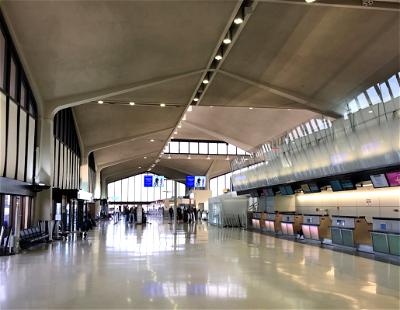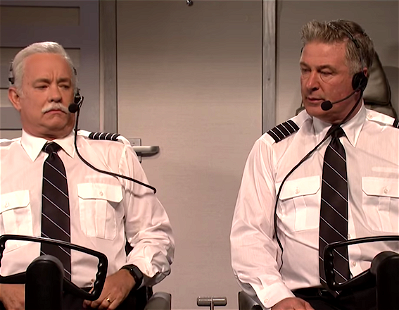Obviously aircraft manufacturers have to do a lot of test flights, not just before they introduce a plane, but before they introduce any updates. At the moment Boeing is testing the Rolls Royce Trent 1000 TEN engines on their 787s, which will reduce fuel burn due to an improved pressure compressor. This also gives airlines more options as to the engine types they want with the plane, since up until now a vast majority of 787s have been equipped with General Electric engines.
In order to certify these engines they first need to do a lot of test flying, including doing some very long flights. So last night a Boeing 787-8 took off from Boeing Field for a nearly 18 hour flight, to test out the engine performance on an ultra longhaul flight. While it might seem logical to fly it on a longhaul journey to Europe and Asia so they can fly in a straight line, it’s a lot easier to fly it domestically in terms of permissions, and also in terms of easily diverting in the event that something goes wrong.
But rather than just flying it back and forth, they decided to have a bit of fun with this, and decided to “draw” a 787 in the sky, with their 787.
When you have to test your new @RollsRoyce engine for 17 hours, you might as well have a bit of fun. pic.twitter.com/8IrBDzomHH
— Flightradar24 (@flightradar24) August 3, 2017
Here’s a timelapse of the flight:
They've done it! I have no idea why they've done it, but @BoeingAirplanes has painted a 787 in the sky.
It took about 12 hours.#AvGeek pic.twitter.com/nAUaQZti4R
— Jason Rabinowitz (@AirlineFlyer) August 3, 2017
The 787 has now finished the 787 drawing formation, and has just over 90 minutes remaining until it arrives back in Seattle. It’s just entering Montana airspace.
How cool is that?! You can track the plane live here.
This isn’t the first time Boeing has done something like this. They did something similar for their 737 MAX, where they drew the “MAX” logo in the sky.
https://twitter.com/flightradar24/status/830585837167509504
However, I’d say the 787 drawing is a bit more impressive. 😉
This is totally unrelated, but is anyone familiar with how these test flights work in terms of crewing? I know they have Boeing test pilots, but is it like a longhaul international flight where you have four pilots and two sleep at a time, or is there more excitement on these test flights, and everyone just has a really long day/night? Do they even have crew bunks on these test planes? I’d be fascinated to learn how this all works.





I hope they had Krug on board
Drawing the tail cone needed some interesting turns
@Lucky - Based on my involvement in ultra-long test flights as an independent consultant for the major aviation gas-turbine manufacturers in my days, most flights beyond 6 hours have two crews - both for rest and for help with instrumentation readings. The hull is not filled with seats, but tons of wiring and row after row of data-acquisition systems and computer consoles gathering millions of data point a second and water ballasts for some specialty...
@Lucky - Based on my involvement in ultra-long test flights as an independent consultant for the major aviation gas-turbine manufacturers in my days, most flights beyond 6 hours have two crews - both for rest and for help with instrumentation readings. The hull is not filled with seats, but tons of wiring and row after row of data-acquisition systems and computer consoles gathering millions of data point a second and water ballasts for some specialty tests in which engine performance is tested with different center of gravity settings. Rarely does anyone sleep on these flights but the pilots monitoring (rather than flying) do have rest seats. The flight crew still has to adhere to the FAA regulations regarding in-flight operational time constraints. Engine qualifications can be interesting, although exciting is not the word I would use to describe it as we pour over data, most of which will be post-processed anyways. The more interesting engine tests are done on the ground.
I know this is a travel-focused blog rather than a general aviation one, but I think "vast majority" is slightly overstating the number of GE engine-equipped 787s - I believe the sales split to date is 55-60% GE and 40-45% RR.
Any report on what type of champagne they served on this flight? lol
that is pretty amazing.
i have flown on boeing 787 a few time across the pacific. mostly to japan haneda airport from lax.
i love the newly refurbished haneda international terminal.
i am trying to fly the new airbus 350 on my next trip to singapore.
from what i can tell, it should be amazing.
@sheena It is the original flight plan, with a margin for error
blue dash - filed/expected route
What are the blue dash lines on the map underneath the green outline?
That is really awesome. I love it when airlines or aircraft manufactures do things like this. It's what Aviation is all about.
Better yet, someone pointed out in a Reddit thread on /r/aviation that the nose is pointing towards Boeing field, while the tail is pointing directly to the factory in South Carolina